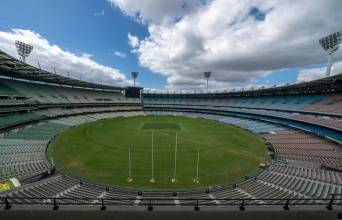Melbourne Cricket Ground

Melbourne Cricket Ground The Melbourne Cricket Ground (MCG), also known simply as "The G", is an Australian sports stadium located in Yarra Park, Melbourne, Victoria. Founded and managed by the Melbourne Cricket Club, it is the largest stadium in the Southern Hemisphere, the 11th largest globally, and the second largest cricket ground by capacity after Motera Stadium.
The MCG is within walking distance of the city centre and is served by Richmond and Jolimont railway stations, as well as the route 70 tram. It is adjacent to Melbourne Park and is part of the Melbourne Sports and Entertainment Precinct. Since it was built in 1853, the MCG has undergone numerous renovations.
It served as the centrepiece stadium of the 1956 Summer Olympics, the 2006 Commonwealth Games and two Cricket World Cups: 1992 and 2015. Noted for its role in the development of international cricket, the MCG hosted both the first Test match and the first One Day International, played between Australia and England in 1877 and 1971 respectively.
It has also maintained strong ties with Australian rules football since its codification in 1859, and has become the principal venue for Australian Football League (AFL) matches, including the AFL Grand Final, the world's highest attended league championship event.
Home to the National Sports Museum, the MCG has hosted other major sporting events, including international rules football matches between Australia and Ireland, international rugby union matches, State of Origin (rugby league) games, and FIFA World Cup qualifiers.
Concerts and other cultural events are also held at the venue with the record attendance standing at 143,750 for a Billy Graham evangelistic crusade in 1959. Grandstand redevelopments and occupational health and safety legislation have limited the maximum seating capacity to approximately 95,000 with an additional 5,000 standing room capacity, bringing the total capacity to 100,024.
The MCG is listed on the Victorian Heritage Register and was included on the Australian National Heritage List in 2005. Journalist Greg Baum called it "a shrine, a citadel, a landmark, a totem" that "symbolises Melbourne to the world".
